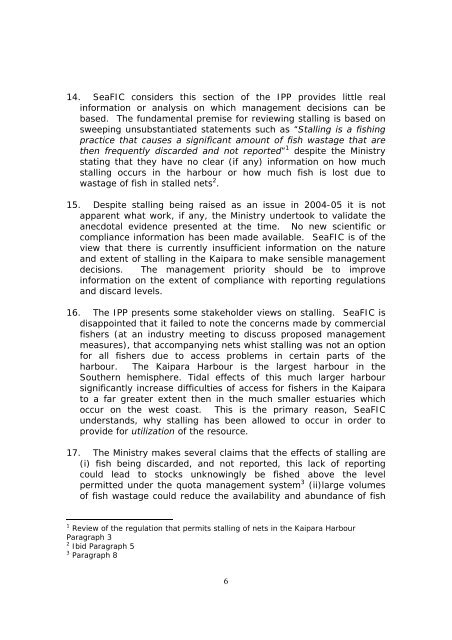The Northern Fisheries Management Stakeholder Company Limited ...
The Northern Fisheries Management Stakeholder Company Limited ...
The Northern Fisheries Management Stakeholder Company Limited ...
Create successful ePaper yourself
Turn your PDF publications into a flip-book with our unique Google optimized e-Paper software.
14. SeaFIC considers this section of the IPP provides little real<br />
information or analysis on which management decisions can be<br />
based. <strong>The</strong> fundamental premise for reviewing stalling is based on<br />
sweeping unsubstantiated statements such as “Stalling is a fishing<br />
practice that causes a significant amount of fish wastage that are<br />
then frequently discarded and not reported” 1 despite the Ministry<br />
stating that they have no clear (if any) information on how much<br />
stalling occurs in the harbour or how much fish is lost due to<br />
wastage of fish in stalled nets 2 .<br />
15. Despite stalling being raised as an issue in 2004-05 it is not<br />
apparent what work, if any, the Ministry undertook to validate the<br />
anecdotal evidence presented at the time. No new scientific or<br />
compliance information has been made available. SeaFIC is of the<br />
view that there is currently insufficient information on the nature<br />
and extent of stalling in the Kaipara to make sensible management<br />
decisions. <strong>The</strong> management priority should be to improve<br />
information on the extent of compliance with reporting regulations<br />
and discard levels.<br />
16. <strong>The</strong> IPP presents some stakeholder views on stalling. SeaFIC is<br />
disappointed that it failed to note the concerns made by commercial<br />
fishers (at an industry meeting to discuss proposed management<br />
measures), that accompanying nets whist stalling was not an option<br />
for all fishers due to access problems in certain parts of the<br />
harbour. <strong>The</strong> Kaipara Harbour is the largest harbour in the<br />
Southern hemisphere. Tidal effects of this much larger harbour<br />
significantly increase difficulties of access for fishers in the Kaipara<br />
to a far greater extent then in the much smaller estuaries which<br />
occur on the west coast. This is the primary reason, SeaFIC<br />
understands, why stalling has been allowed to occur in order to<br />
provide for utilization of the resource.<br />
17. <strong>The</strong> Ministry makes several claims that the effects of stalling are<br />
(i) fish being discarded, and not reported, this lack of reporting<br />
could lead to stocks unknowingly be fished above the level<br />
permitted under the quota management system 3 (ii)large volumes<br />
of fish wastage could reduce the availability and abundance of fish<br />
1<br />
Review of the regulation that permits stalling of nets in the Kaipara Harbour<br />
Paragraph 3<br />
2<br />
Ibid Paragraph 5<br />
3<br />
Paragraph 8<br />
6
















